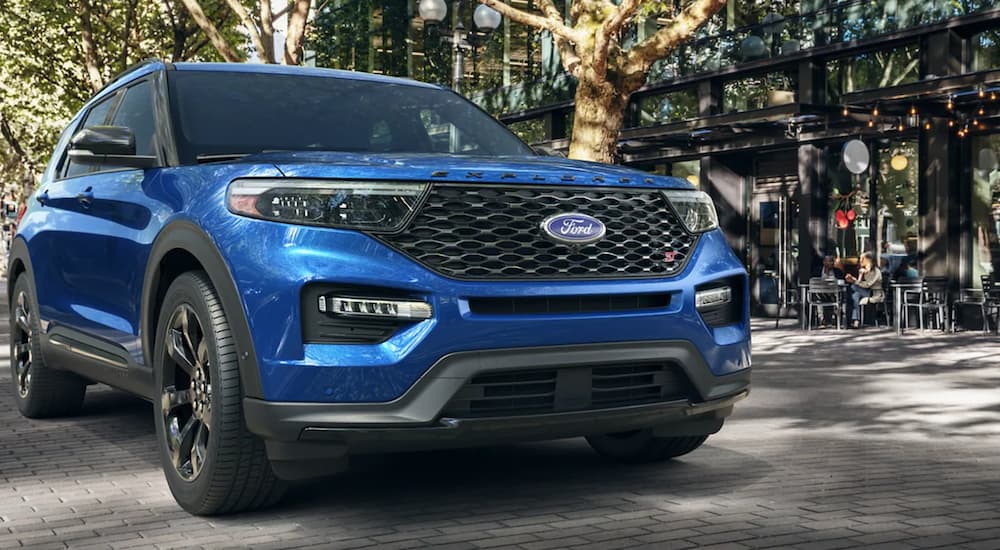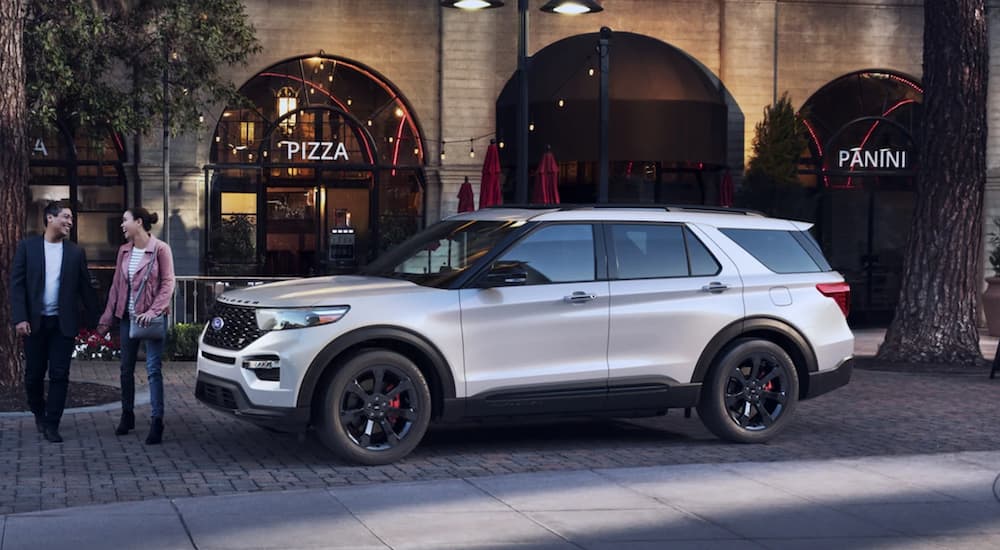How do you take your Ford Explorer? Two doors or four? Rear-wheel drive or four-wheel drive? Cheap or luxurious? This ubiquitous ute arguably kick-started the SUV revolution, and the many available trims and configurations have led to category-leading sales almost every year since it first launched in the early ’90s. Can Ford continue reinventing America’s favorite SUV? Survey says yes, with the new 2022 Ford Explorer adding a performance ST-Line trim that’s aimed squarely at enthusiasts.
The new Explorer ST-Line falls in the middle of the price spectrum, making it accessible to cost-conscious buyers. It joins the existing ST trim – found a few rungs higher on the trim range – as the second most performance-focused Explorer flavor. Central to the ST-Line’s sporty driving manners is its standard rear-wheel drive, but for this trim, it’s all about image.
As the Explorer nameplate ages, relevancy is the name of the game. Ford admirably invests in its iconic midsize SUV year after year, but with this new crop of performance-oriented trims, the game changes significantly. Will the ST-Line and ST eventually oust the luxury King Ranch and Platinum trims for flagship status? It’s doubtful, but these two trims could reinvigorate the Explorer and draw the attention of enthusiast buyers.
Explorer ST-Line vs Explorer ST
Ford carries over the ST from the previous model year, but the mid-priced ST-Line is brand new. Why offer a less expensive version of the go-fast ST? It’s all about appearances. One in five Explorers purchased are STs, but the higher price tag alienates a slew of more budget-minded buyers who favor the trim for its sporty styling. Ford recognized this and answered with a less powerful version of the original. In doing so, the ST’s aesthetics are more approachable for image-focused buyers.
Ford didn’t just slap an ST badge on the ST-Line – the trim differentiates itself enough to earn its own spot in the lineup. It’s several thousand less than the ST, mostly thanks to the smaller four-cylinder engine under the hood, but it shares the same oversized 20-inch wheels and interior features as its more expensive sibling. The ST combines its larger engine with a special sport-tuned suspension to achieve its impressive street performance. You’ll find neither on the lesser-priced ST-Line.
Which trim you buy depends on whether you want to back up the sporty styling with equally sporty performance. Opting for the more expensive ST buys you roughly 100 more horsepower and 100 extra lb-ft of torque. Still, if that isn’t important, the ST-Line’s black ActiveX Seating with Miko inserts and cherry red stitching, along with a blacked-out grille and shiny black Explorer hood badging, will suffice. It’s a different take on a family SUV, something a lot of buyers are craving.
The ST can be had with a series of add-ons, including the ST High-Performance Pack, which adds 21-inch aluminum wheels and a set of high-performance brakes with red calipers. Adding the Premium Technology package outfits the cabin with a 10.1-inch portrait-mounted infotainment touchscreen and special Active Motion Multicontour front seats. The package also includes a 14-speaker B&O sound system that’s rated at 980 watts. The ST-Line isn’t as customizable, but buyers can decide between second-row captain’s chairs or bench seating.
Performance and Powertrain Features
Ford’s smaller four-cylinder engine powers the ST-Line, while the more expensive ST receives a powerful V6. Both are mated to a smooth 10-speed automatic transmission with a nice low-range distribution of torque. The turbocharged 2.3-liter EcoBoost four-cylinder makes 300 horsepower and an admirable 310 lb-ft of torque, but that’s nothing compared to the ST’s 3.0-liter EcoBoost V6, which delivers 400 horsepower and 415 lb-ft of torque. Both engines are remarkably fuel-efficient.
For a handful of buyers, the concept of a rear-wheel drive SUV is oxymoronic. We get it, since the category is founded on utility and capability. The Explorer was and is built with this segment of buyers in mind, but that’s exactly what makes the ST-Line and ST trims so special. Ford isn’t content to sit back and enjoy a steady stream of sales from mainstream buyers; instead, the company reveals a bit of the long game, which involves committing to SUV innovation where it counts the most. Also, Ford isn’t afraid to experiment with its most successful nameplates. One look at the all-electric F-150 Lightning and the Mustang Mach-E confirms the company’s appetite for risk-taking.
Both performance trims feature standard rear-wheel drive. It’s lighter than four-wheel drive, thus contributing to faster acceleration and a drastically different set of handling characteristics. Rear-wheel drive is the drivetrain of choice for enthusiasts, and on the Explorer ST-Line and ST, it’s nothing short of transformative. We’re somewhat surprised the Timberline off-road trim is getting all the headlines, especially since off-road capability isn’t a new storyline for the Explorer.
ST-Line and ST buyers do have the option of adding four-wheel drive for an extra cost, but if off-roading is the plan, a closer look at the specially equipped Timberline trim probably makes more sense. Both ST trims benefit from all the equipment and features found on other Explorers, including three rows of seats and up to 87.8 cubic feet of cargo space with both back rows folded flat, so family buyers looking for more performance don’t have to sacrifice utility. Ford CoPilot 360, a suite of driver-assist systems, is also included.
Stacking Up to the Competition
Part of owning a performance SUV is having bragging rights. Can Explorer ST owners boast the best overall hot-rodding capability, or is there a hidden competitor that deserves the number one spot? Aside from European go-fast SUVs with triple-digit price tags, few reasonably priced sport SUVs directly compete with the Explorer ST. Just one – the Dodge Durango SRT 392 – comes to mind. While the Durango boasts better stats, its brutish curb profile and lack of amenities might be off-putting to potential buyers.
These two vehicles, the Explorer ST and the Durango SRT 392, couldn’t be more different. While the Explorer offers more refined styling, a larger cabin, and better in-vehicle technology, the Durango prefers its old-school muscle car bones, including the big V8 engine and brawny exterior profile. Comparably equipped, the Durango comes in around $20,000 higher than the Explorer ST, a reality that offsets its superior zero-to-sixty stat and puts it out of reach for many buyers.
If a beefy muscle car vibe isn’t quite fitting your family narrative, best to stick with the Explorer ST. It quite literally has no other competition in the segment, at least none that’s specifically branded a performance SUV. In that way, the Explorer ST-Line and ST are unicorns. For many 7-seater SUV buyers, different is good. The vanilla styling present within the prime midsize SUV category is intentional, of course, because coloring outside the lines is dangerous with your high-volume nameplates.
SUV buyers still demand utility and capability, which is why family-friendly features like rear entertainment systems and hands-free liftgates should headline the list of standard equipment on vehicles like the Explorer. Still, Ford’s decision to add flashy performance trims shows just a hint of rebellion. That the ST represents 20 percent of all Explorers sold isn’t surprising. It reveals buyers’ interest in bucking the norm just a little, but not too much. Will other automakers respond? Our guess is yes. But for now, if it’s the speed you want, the Explorer ST stands alone.






